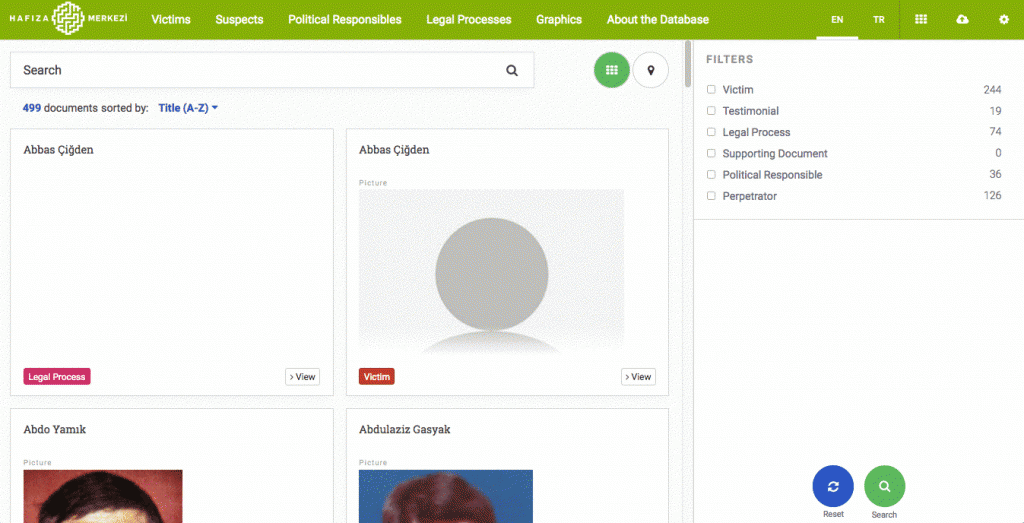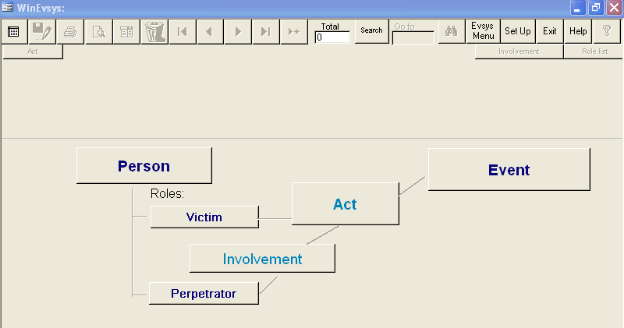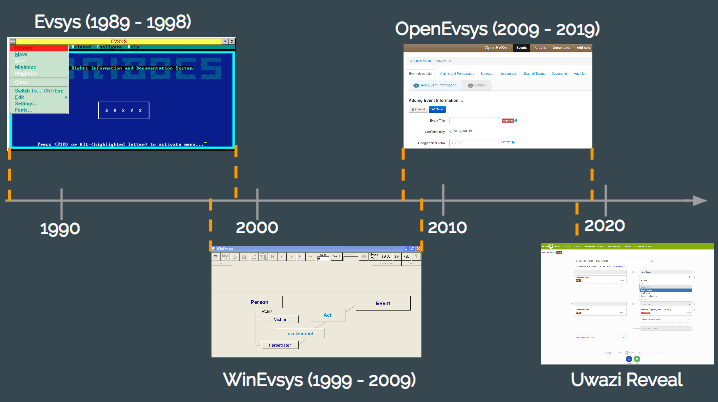Documenting human rights violations is a crucial part in ongoing or potential transitional justice efforts, as it often leads to national and international litigation or supports (future) transitional justice mechanisms. Providing technological and methodological support to these documentation efforts is at the heart of HURIDOCS’ work.
For more than three decades, HURIDOCS has developed free, open source tools to support human rights documentation:
- Evsys was a DOS application built in 1989. The name comes from the methodology that it’s based on, called the Events Standard Methodology.
- WinEvsys was built on Microsoft Access and superseded Evsys in the 2000s.
- And finally OpenEvsys, our first web application, was initially released in 2009 and is supported until today.
One of our long-term partners, Hafiza Merkezi, has been using OpenEvsys to document enforced disappearances in Turkey and use this documentation for memorialisation, criminal prosecution, finding the whereabouts of the person, advocacy and lobbying to change or improve policies. Now, with over 500 cases documented in their OpenEvsys database, Hafiza Merkezi needs a more sophisticated system. Overall, OpenEvsys is working well, but it is built around a workflow that does not really reflect their changing needs. Hafiza Merkezi also wants advanced support for their analysis of documents, photos and videos.
Hafiza Merkezi is just one of the many human rights organisations that need secure and user-friendly solutions to help support the digitisation, automated classification, and analysis of thousands of documents that play crucial role in the important work they do.
To address Hafiza Merkezi’s evolving documentation needs, as well as the needs of many of our old and new partners, HURIDOCS is embarking on a complete redesign and redevelopment of OpenEvsys. We’re combining our knowledge working with our OpenEvsys users with the possibilities offered by new technology to provide:
- new and more powerful ways to search and organise documents and other source files,
- automated classification of documents using machine learning, and
- advanced and user-friendly data visualisation and analysis.
This platform, which we’ve given the working name of Uwazi Reveal, will build on the innovative features of our existing database application Uwazi. Combined with the ability to design rigorous and appropriate data models in a user-friendly way, defenders will be able to generate reliable conclusions from collected data. This new tool will support human rights investigations managing large amounts of source documents and media to advance transitional justice efforts and evidence-based advocacy, all while meeting the pressing security needs of human rights organisations.
The technology stack we are using includes: Mongo DB, NodeJS, Elastic Search, Yarn, React. Learn more about these dependencies on Github.
It will make it easy to record connections between people, documents, and events in a way that speaks best to the logic of the investigating organisation. We will offer multiple workflows and ways to organise information, which will give flexibility where it is needed for a given context.
Approach 1: Starting at the source to build layers of metadata
One approach will be to organise your data around the source information: a written testimony, a video of an event, or a picture of a victim. This next generation of Uwazi will offer intuitive and iterative steps to create profiles of people you are holding information on and the events your information covers.
This approach is particularly helpful for organisations that are actively learning about the people and events that are described in their source documents. The tool will allow researchers to investigate and organise their source information while building layers of connections and metadata around it in order to reveal patterns and trends.

The gif above demonstrates how the platform will offer new ways to create connections (document-person, photo-document, etc.) that unlock serious investigative capacity. Based on these connections, users will be able to see visual representation of this analysis in maps, charts, and graphs. Users can also search and filter based on connection metadata.
Users will be able to explore and analyse data to see if they support hypotheses on accountability and chain of command. Organisations will also be able to uncover new insights in the collection, such as: the frequency of references, and patterns within content and connections. It can bring to light new relationships between the information in your collection and the people, events and institutions that surround them.
Approach 2: Organising existing evidence using known data models
This expanded version of Uwazi will allow users to apply a known data model of the already-known persons, cases and events, and then linking documents and other media to these nodes. In this way, the collection of documents and other files provide evidence and contextual information to the events already identified by the organisation’s research and investigation. Uwazi Reveal will provide additional analysis and visualisation for this kind of approach.
In addition to users configuring the platform with a known data model, Uwazi will offer and support HURIDOCS’ Events Standard Methodology, which uses the “Who Did What to Whom” data model.

This methodology and data model allow monitoring groups to organise their information about human rights violations in a structured and comprehensive format in order to analyse patterns of violence.
Additional Features
Automated classification of documents using machine learning
Machine learning is now more accessible (open source) and applicable to new tools being developed in order to automate the classifications of thousands of documents. Integrating machine learning will enable human rights organisations who have large stacks of physical (or digital) documents to automatically categorise them and uncover patterns undetected by a human eye. Read more about our plans for this integration.
Advanced security features
There are many documentation projects that involve multiple teams uploading and organising information. But this can pose a significant security risk – the more people with accounts to your system, the more opportunities for an adversary to hijack an account and gain access. That’s why we’re putting in place an advanced roles and permissions system so that a user only access to what that person needs. To further mitigate against an adversary trying to access the system through an existing user account (via spear fishing), we will integrate two factor authentication during user login. And, to be able to monitor the activities of the users (including any unwanted users), we will develop a user friendly audit log for administrators. These features as well as others, will be audited by security experts in which they will try to hack the system (and all of our code will be open source, making it available and auditable to anyone).
Our Timeline
By early 2019, we plan to have Uwazi for documenting violations released. But we have many important pieces that we need to build before then with the help of partners and funders. For example, for collecting information securely, we’re exploring partnerships with OpenArchive and with Build a Movement to integrate their Whistler mobile app.
We want to make this a global endeavour, co-designed with human rights defenders, so your support to make it that would be invaluable. If you have any feedback for us, don’t hesitate to get in touch. Thank you!
